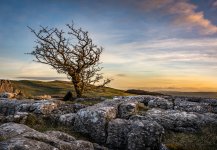G
Guest 183
New member
- Jun 29, 2022
- 21
- 47
These are my thoughts brought up while preparing a talk for camera clubs. The biggest single difference to the quality of my photography occurred when I stopped "taking the View" and started looking at and analysing what was it about " the View" that interested me. In landscape photography it is not always simple to do this. With other genres it is obvious, or at least, it should be obvious. Portraiture, wildlife etc the subject is obvious although with environmental portraits or showing the wildlife in context the subject may be small but and this is the important part the image should obviously be about the bird, person, flower etc and the rest of the image telling you something more about the subject. For instance, where does it live, what does that look like, or what do they do, what do they like, who are their friends. If you are lucky or good at composition then the material around the subject may be arranged in a harmonious manner with leading lines or a good background, harmonious colours and nothing intruding that takes attention away from the subject. Getting back to landscapes, my usual photographic material, we can apply exactly the same thoughts to them. Once you have decided what has grabbed your interest, I hope that it has excited you, first question where is the light coming from, if it is a tree you can probably move to get the light in your preferred position if it is a mountain then you may have to move a very long distance or wait until the sun moves. Sometimes it may be several months before the light is in the right position but let us assume that you can get the light in a good enough area. Next the quality of the light, if it is a blue sky day with strong sunshine then you are unlikely to produce a jaw dropping image but you are in the countryside so make the best of it. Next ask yourself, where am I going to place the subject in the frame? You can use the rule of thirds if you wish I often don't I place it where it looks best to me. Now what is in the foreground that either tells you something about the subject or guides your eye towards the subject? If you are lucky it may do both. How large is this foreground, if too small move closer and use a wider angle lens, if too large move back and use a longer lens. Strictly speaking this does not change the size of the foreground element but changes the size of the subject, using a longer lens on a mountain makes it larger in the frame, moving a few metres back doesn't really change the distance to the mountain. If it is a tree or waterfall that is 20m away with a foreground rock that is 1m away, moving back 2m will make the tree/ waterfall approx 10% smaller but the foreground rock 66% smaller. Zooming in 10% will restore the tree/ waterfall but the foreground rock will still be 60% smaller. This changing of relative sizes is a great deal different from the usual" zoom with your feet" advice given, zoom lenses allow you to easily change the relative sizes of elements in your image. A selection of prime lenses also allow you to do this but not as easily or precisely. Sometimes it issn't possible to just back up a bit for a variety of reasons. As well as moving back and forth, a small movement to the side or up and down can radically change the position of foreground elements. Now the background, is it harmonious? you can change it by moving but this may wreck your carefully chosen foreground, getting a place with an interesting subject with a good foreground and background and the likelihood is that it has been photographed a million times before. What do you try and leave out of the image? Everything that you can that doesn't add to the story is the simple answer that is often very difficult to achieve. Some landscape locations are complex and the images from them are complex and busy but my images used to complex and busy even when they didn't need to be. Lastly the idea of working out exactly what the subject is gives you the first clue as to whether the image is any good. You were interested in an ancient tree well is it obvious that that is what the image is about. I used to attend national and international photographic competitions and exhibitions and with many landscape images it was not obvious what had attracted the photographer with exhibitions it was almost always obvious. I know that this is a complex piece and many of you are not English native speakers but inserting the images to illustrate the points would make this very long and complex. Feel free to disagree this is what works for me and may not for you, I could change my approach in the future as I have in the past. Winskill Stones, North Yorkshire, Nikon D810. Ken
